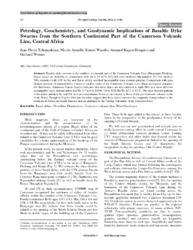Petrology, Geochemistry, and Geodynamic Implications of Basaltic Dyke Swarms from the Southern Continental Part of the Cameroon Volcanic Line, Central Africa
Zeitschrift: The Open Geology Journal, 20126, 1: 72 - 84
DOI: https://doi.org/10.2174/1874262901206010072
Persistent URL: http://resolver.sub.uni-goettingen.de/purl?gldocs-11858/6809
Persistent URL: http://resolver.sub.uni-goettingen.de/purl?gldocs-11858/6809
Tchouankoue, Jean Pierre; Wambo, Nicole Armelle Simeni; Dongmo, Armand Kagou; Wörner, Gerhard, 2012: Petrology, Geochemistry, and Geodynamic Implications of Basaltic Dyke Swarms from the Southern Continental Part of the Cameroon Volcanic Line, Central Africa. In: The Open Geology Journal, Band 6, 1: 72 - 84, DOI: 10.2174/1874262901206010072.
 |
Dokument öffnen: |
Basaltic dyke swarms in the southern continental part of the Cameroon Volcanic Line (Bangangte, Dschang,
Manjo areas) are tholeiitic in composition with 46 to 50 wt.% SiO
2
and have moderate Mg-numbers (53–59), medium
TiO
2
contents (1.48–2,05 wt.%), and flat to mildly enriched incompatible trace element patterns. Comparison with trace
element patterns of representative Cenozoic basaltic rocks of the Cameroon Volcanic Line (Bana anorogenic complex,
Mt. Bambouto, Adamawa Plateau basalts) indicates that these dykes are less enriched in light REE and show different
incompatible trace element ratios (La/Yb: 5.7 to 8.6; Zr/Nb: 7.6 to 12.0; Ba/Th: 87.7 to 93.3). The trace element patterns
of the dykes and their Sr- and Nd- isotope compositions, however, are similar to those of the pre-Cenozoic volcanic rocks
of the Benue Trough in Nigeria. Our data therefore suggest that these dykes represent the magmatic history related to the
break-up of Africa and South America and are unrelated to the Tertiary volcanism of the Cameroon Line.
Statistik:
ZugriffsstatistikSammlung:
- Geologie [933]


